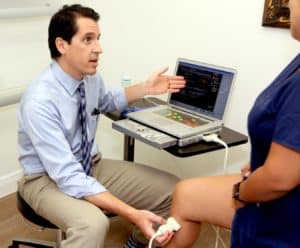Restless leg syndrome (RLS), also known as Willis-Ekbom disease, is a condition that causes an uncontrollable urge to move the legs. Those with restless leg syndrome often experience symptoms worse in the evening or nighttime hours when they are more sedentary. However, moving around typically eases the uncomfortable sensation or severe symptoms temporarily.
It’s important to note that RLS can begin at any age and generally worsens as time goes on. Depending on the severity, it can disrupt sleep and sleep hygiene and even interfere with daily activities. Here at East Bay Vein Specialists, we want to help you be proactive about your health. Read on to learn the signs of restless leg syndrome and 9 effective ways to prevent it.
Signs of Restless Leg Syndrome
The main symptom associated with restless leg syndrome is the urge to move your legs. Other signs that indicate you have restless leg syndrome include:
Sensations at Rest
Those with RLS will often experience an uncomfortable sensation that begins while resting. Typically, this sensation will occur after lying down or sitting for an extended period of time. For instance, sitting in a car or being on an airplane for an extended time can trigger RLS creating an irresistible urge to move your legs.
Relief With Movement
Another sign of restless leg syndrome is that you notice relief upon movement. The sensation of RLS can be uncomfortable, but performing movements such as stretching, shaking your legs, or walking can minimize the symptoms.
Worsening Symptoms in the Evening
You may notice that the symptoms of RLS become worse at night when sitting or lying down for a long time.
Leg Twitching at Night
Restless leg syndrome is sometimes associated with a more common condition called periodic limb movement in sleep. This condition causes the legs to kick and twitch. This movement may happen occasionally, but it can also occur throughout the night causing sleep disorder.
Many people living with restless leg syndrome describe the sensation as unpleasant and occurs throughout the legs and feet. Even more, this sensation occurs within the limbs rather than on the skin. The sensation/medical conditions can be described as:
- Aching
- Throbbing
- Crawling
- Creeping
- Itching
- Electric

9 Ways to Prevent Restless Leg Syndrome
Restless leg syndrome can certainly disrupt your quality of life. The good news is that there are measures you can take to prevent RLS or minimize your symptoms if you are already living with this condition. Here are 9 ways to combat RLS.
1. Rule Out Possible Causes
Sometimes, restless leg syndrome is due to an underlying cause. If you believe you have restless leg syndrome, you may be able to reverse the symptoms by ruling out things that could be potentially causing it. Here are a few possible underlying causes of RLS symptoms.
Certain Habits
Certain lifestyle habits, such as the use of caffeine, alcohol, and tobacco can increase the symptoms associated with restless leg syndrome. Limiting your consumption may help reduce your symptoms.
Some Medications
Taking some medication can worsen the symptoms associated with RLS. For instance, older medications, such as Benadryl can worsen symptoms. Antinausea drugs like Reglan and Compro can increase the symptoms of RLS as well. Other medications that can worsen symptoms include:
- Antipsychotic drugs
- Lithium
- Some serotonin reuptake inhibitors
- Tricyclic antidepressants
Health Conditions
There are some health conditions or medical history that have been found to increase the symptoms associated with RLS. For example, end-stage renal disease and nerve damage from diabetes have been linked to worsening symptoms of restless leg syndrome. It has also been said that an iron deficiency or strange iron levels can be a cause of RLS.
Other Triggers
There are other things that may trigger RLS. For instance, some individuals have reported that eating too much sugar or wearing tight clothing triggers their restless leg syndrome.
2. Adopt Healthy Sleeping Habits
Another way to reduce RLS symptoms is by adopting healthy sleeping habits. It’s important to note that improving your sleeping habits (decreasing sleep disruption) may not improve your symptoms, but it may be able to help you combat the sleep you lose from your symptoms. With that said, you can try the following:
- Going to sleep and waking up at the same time each day
- Keep your sleeping environment dark and quiet
- Remove any distractions that can disrupt sleep, such as a TV
- Prevent any daytime sleepiness
3. Incorporate Iron and Vitamin Supplements
Some research suggests that iron deficiencies could be linked to RLS. For this reason, it may be beneficial to incorporate iron supplements if your blood is low. But before taking iron supplementation, be sure to talk with your doctor and ask them to run a blood test to ensure you have a deficiency.
4. Exercise
Since RLS becomes worse at rest, incorporating exercise is an excellent way to not only improve your health but combat your symptoms. Additionally, exercise is linked to improved sleep, which can also help alleviate sleep disturbances generally caused by restless leg syndrome.
5. Stretching
Incorporating stretching into your routine is excellent for those with RLS. Activities that stretch the body, such as yoga, are a great treatment options to get the legs and feet moving. In addition to this, stretching can boost your mood and helps to relieve stress, which aids in better sleep.
6. Massage
It’s possible that massages can help minimize the symptoms of restless leg syndrome. Different types of massage techniques, such as Swedish massage and Deep Tissue massage can help wake up the nerves in your legs and feet and reduce the feeling of being sedentary and leg cramps.
7. Prescription Medicine
One of the best ways to reduce the symptoms of RLS is through prescription medication. In fact, there are various medications that are designed to manage moderate to severe RLS. Here are two common medications prescribed to RLS patients:
- Dopaminergic drugs: This is the most commonly prescribed medication. It increases the dopamine in your brain and can be effective in relieving RLS symptoms since individuals living with this condition have a problem producing dopamine naturally.
- Gabapentin: It is still not known how this medication relieves RLS symptoms, but studies show that it has been effective in helping.
8. Pneumatic Compression
This type of compression uses a sleeve that goes over your leg. It inflates and deflates, which gently squeezes and releases your limbs. Pneumatic compression improves circulation, prevents blood clots, and is helpful in alleviating RLS symptoms.
9. Foot Wrap
A foot wrap, such as a restiffic, has been shown to relieve RLS symptoms. This particular foot wrap puts pressure on certain parts of your foot, which then sends a message to the brain. This message triggers the limbs affected by RLS to relax.
Do you have restless leg syndrome or believe you have the condition? Then it’s time to talk with a specialist. Here at Easy Bay Vein Specialists, we want to help you improve your quality of life through personalized treatment. Contact us today to see how we can help.



